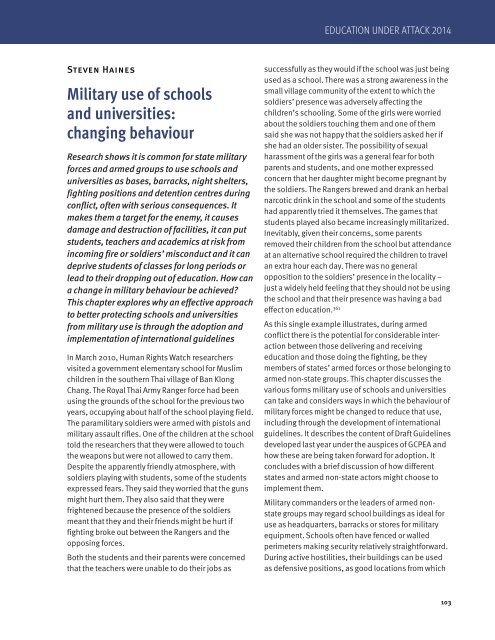eua_2014_full.pdf?utm_content=buffer4a392&utm_medium=social&utm_source=twitter
eua_2014_full.pdf?utm_content=buffer4a392&utm_medium=social&utm_source=twitter
eua_2014_full.pdf?utm_content=buffer4a392&utm_medium=social&utm_source=twitter
- No tags were found...
You also want an ePaper? Increase the reach of your titles
YUMPU automatically turns print PDFs into web optimized ePapers that Google loves.
EDUCATION UNDER ATTACK <strong>2014</strong>Steven HainesMilitary use of schoolsand universities:changing behaviourResearch shows it is common for state militaryforces and armed groups to use schools anduniversities as bases, barracks, night shelters,fighting positions and detention centres duringconflict, often with serious consequences. Itmakes them a target for the enemy, it causesdamage and destruction of facilities, it can putstudents, teachers and academics at risk fromincoming fire or soldiers’ misconduct and it candeprive students of classes for long periods orlead to their dropping out of education. How cana change in military behaviour be achieved?This chapter explores why an effective approachto better protecting schools and universitiesfrom military use is through the adoption andimplementation of international guidelinesIn March 2010, Human Rights Watch researchersvisited a government elementary school for Muslimchildren in the southern Thai village of Ban KlongChang. The Royal Thai Army Ranger force had beenusing the grounds of the school for the previous twoyears, occupying about half of the school playing field.The paramilitary soldiers were armed with pistols andmilitary assault rifles. One of the children at the schooltold the researchers that they were allowed to touchthe weapons but were not allowed to carry them.Despite the apparently friendly atmosphere, withsoldiers playing with students, some of the studentsexpressed fears. They said they worried that the gunsmight hurt them. They also said that they werefrightened because the presence of the soldiersmeant that they and their friends might be hurt iffighting broke out between the Rangers and theopposing forces.Both the students and their parents were concernedthat the teachers were unable to do their jobs assuccess<strong>full</strong>y as they would if the school was just beingused as a school. There was a strong awareness in thesmall village community of the extent to which thesoldiers’ presence was adversely affecting thechildren’s schooling. Some of the girls were worriedabout the soldiers touching them and one of themsaid she was not happy that the soldiers asked her ifshe had an older sister. The possibility of sexualharassment of the girls was a general fear for bothparents and students, and one mother expressedconcern that her daughter might become pregnant bythe soldiers. The Rangers brewed and drank an herbalnarcotic drink in the school and some of the studentshad apparently tried it themselves. The games thatstudents played also became increasingly militarized.Inevitably, given their concerns, some parentsremoved their children from the school but attendanceat an alternative school required the children to travelan extra hour each day. There was no generalopposition to the soldiers’ presence in the locality –just a widely held feeling that they should not be usingthe school and that their presence was having a badeffect on education. 361As this single example illustrates, during armedconflict there is the potential for considerable interactionbetween those delivering and receivingeducation and those doing the fighting, be theymembers of states’ armed forces or those belonging toarmed non-state groups. This chapter discusses thevarious forms military use of schools and universitiescan take and considers ways in which the behaviour ofmilitary forces might be changed to reduce that use,including through the development of internationalguidelines. It describes the content of Draft Guidelinesdeveloped last year under the auspices of GCPEA andhow these are being taken forward for adoption. Itconcludes with a brief discussion of how differentstates and armed non-state actors might choose toimplement them.Military commanders or the leaders of armed nonstategroups may regard school buildings as ideal foruse as headquarters, barracks or stores for militaryequipment. Schools often have fenced or walledperimeters making security relatively straightforward.During active hostilities, their buildings can be usedas defensive positions, as good locations from which103


